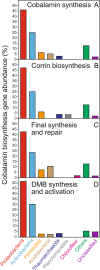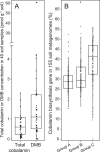Metagenomic and chemical characterization of soil cobalamin production
- PMID: 31492962
- PMCID: PMC6908642
- DOI: 10.1038/s41396-019-0502-0
Metagenomic and chemical characterization of soil cobalamin production
Abstract
Cobalamin (vitamin B12) is an essential enzyme cofactor for most branches of life. Despite the potential importance of this cofactor for soil microbial communities, the producers and consumers of cobalamin in terrestrial environments are still unknown. Here we provide the first metagenome-based assessment of soil cobalamin-producing bacteria and archaea, quantifying and classifying genes encoding proteins for cobalamin biosynthesis, transport, remodeling, and dependency in 155 soil metagenomes with profile hidden Markov models. We also measured several forms of cobalamin (CN-, Me-, OH-, Ado-B12) and the cobalamin lower ligand (5,6-dimethylbenzimidazole; DMB) in 40 diverse soil samples. Metagenomic analysis revealed that less than 10% of soil bacteria and archaea encode the genetic potential for de novo synthesis of this important enzyme cofactor. Predominant soil cobalamin producers were associated with the Proteobacteria, Actinobacteria, Firmicutes, Nitrospirae, and Thaumarchaeota. In contrast, a much larger proportion of abundant soil genera lacked cobalamin synthesis genes and instead were associated with gene sequences encoding cobalamin transport and cobalamin-dependent enzymes. The enrichment of DMB and corresponding DMB synthesis genes, relative to corrin ring synthesis genes, suggests an important role for cobalamin remodelers in terrestrial habitats. Together, our results indicate that microbial cobalamin production and repair serve as keystone functions that are significantly correlated with microbial community size, diversity, and biogeochemistry of terrestrial ecosystems.
Conflict of interest statement
The authors declare that they have no conflict of interest.
Figures






Similar articles
-
Microbial and Genetic Resources for Cobalamin (Vitamin B12) Biosynthesis: From Ecosystems to Industrial Biotechnology.Int J Mol Sci. 2021 Apr 26;22(9):4522. doi: 10.3390/ijms22094522. Int J Mol Sci. 2021. PMID: 33926061 Free PMC article. Review.
-
Aquatic metagenomes implicate Thaumarchaeota in global cobalamin production.ISME J. 2015 Feb;9(2):461-71. doi: 10.1038/ismej.2014.142. Epub 2014 Aug 15. ISME J. 2015. PMID: 25126756 Free PMC article.
-
Soil microbial community response to corrinoids is shaped by a natural reservoir of vitamin B12.ISME J. 2024 Jan 8;18(1):wrae094. doi: 10.1093/ismejo/wrae094. ISME J. 2024. PMID: 38832716 Free PMC article.
-
Two distinct pools of B12 analogs reveal community interdependencies in the ocean.Proc Natl Acad Sci U S A. 2017 Jan 10;114(2):364-369. doi: 10.1073/pnas.1608462114. Epub 2016 Dec 27. Proc Natl Acad Sci U S A. 2017. PMID: 28028206 Free PMC article.
-
Microbial diversity of hypersaline environments: a metagenomic approach.Curr Opin Microbiol. 2015 Jun;25:80-7. doi: 10.1016/j.mib.2015.05.002. Epub 2015 Jun 8. Curr Opin Microbiol. 2015. PMID: 26056770 Review.
Cited by
-
A metabolic modeling-based framework for predicting trophic dependencies in native rhizobiomes of crop plants.Elife. 2024 Oct 17;13:RP94558. doi: 10.7554/eLife.94558. Elife. 2024. PMID: 39417540 Free PMC article.
-
Growth rate is a dominant factor predicting the rhizosphere effect.ISME J. 2023 Sep;17(9):1396-1405. doi: 10.1038/s41396-023-01453-6. Epub 2023 Jun 15. ISME J. 2023. PMID: 37322285 Free PMC article.
-
Microbial and Genetic Resources for Cobalamin (Vitamin B12) Biosynthesis: From Ecosystems to Industrial Biotechnology.Int J Mol Sci. 2021 Apr 26;22(9):4522. doi: 10.3390/ijms22094522. Int J Mol Sci. 2021. PMID: 33926061 Free PMC article. Review.
-
Functional Insights into the Kelp Microbiome from Metagenome-Assembled Genomes.mSystems. 2022 Jun 28;7(3):e0142221. doi: 10.1128/msystems.01422-21. Epub 2022 Jun 1. mSystems. 2022. PMID: 35642511 Free PMC article.
-
Inter-bacterial mutualism promoted by public goods in a system characterized by deterministic temperature variation.Nat Commun. 2023 Sep 5;14(1):5394. doi: 10.1038/s41467-023-41224-7. Nat Commun. 2023. PMID: 37669961 Free PMC article.

